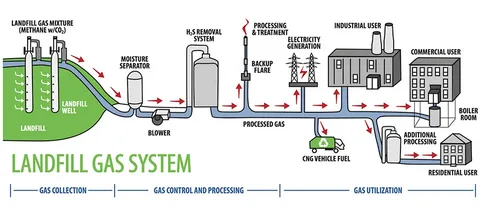Introduction
The landfill gas (LFG) market is expanding as global focus on renewable energy and waste management grows. Landfill gas is produced through the decomposition of organic waste in landfills and primarily consists of methane (CH₄) and carbon dioxide (CO₂). Capturing and utilizing this gas provides a renewable energy source while reducing greenhouse gas emissions. LFG can be used for electricity generation, heating, and as a fuel for vehicles, making it an integral part of sustainable waste management and renewable energy strategies. With increasing urbanization and solid waste generation, the LFG market presents significant opportunities for governments and private sector players.
Market Drivers
The main driver of the landfill gas market is the increasing demand for clean and renewable energy. Capturing methane from landfills helps mitigate environmental hazards associated with uncontrolled emissions, such as global warming and air pollution. Government incentives, subsidies, and regulatory mandates for waste-to-energy projects are supporting market growth. Additionally, growing urban populations are generating more municipal solid waste, leading to higher LFG potential. Technological advancements in gas capture, purification, and utilization, as well as rising interest in carbon credits and emissions trading, are further boosting the market.
Market Challenges
Despite its potential, the landfill gas market faces several challenges. High initial capital investment for gas collection and power generation facilities can hinder adoption, especially in developing countries. Technical challenges include effective gas collection, handling of impurities, and maintaining consistent gas quality. Regulatory compliance, environmental permits, and community concerns can delay project implementation. Market volatility in energy prices and competition from other renewable sources, such as solar and wind, may also impact profitability. Additionally, inefficient waste segregation and inadequate landfill management practices can limit gas production potential.
Market Segmentation
The LFG market can be segmented by application, technology, and end-user.
- By Application: Electricity generation, direct-use applications (heating, industrial processes), and vehicle fuel (compressed natural gas). Electricity generation is the largest segment, while direct-use applications and vehicle fuel are growing steadily.
- By Technology: Gas collection systems, purification systems, and energy conversion systems. Advanced purification and conversion technologies enhance energy efficiency and reduce emissions.
- By End-User: Utilities, industrial and commercial establishments, and municipal authorities. Utilities are increasingly investing in LFG-to-power projects to enhance renewable energy portfolios.
Regional Insights
The landfill gas market varies significantly across regions. North America, led by the U.S. and Canada, dominates the market due to stringent environmental regulations, advanced waste management infrastructure, and high renewable energy adoption. Europe is also a strong market, with countries like Germany, the U.K., and France investing in LFG-to-energy projects to meet sustainability goals. Asia-Pacific, including China, Japan, and India, is witnessing rapid growth due to urbanization, increasing waste generation, and supportive government policies. Latin America and Middle East & Africa are emerging markets, gradually adopting LFG projects as part of sustainable waste management initiatives.
Key Market Trends
Several trends are shaping the landfill gas industry. Integration of advanced gas capture and purification systems improves efficiency and energy output. Hybrid projects, combining LFG with solar or wind energy, are gaining traction to optimize energy production. The use of compressed LFG as vehicle fuel is emerging as a sustainable transportation solution. Smart monitoring and IoT-enabled landfill management systems are being implemented to enhance gas collection efficiency and safety. Additionally, carbon credit trading and ESG initiatives are encouraging companies to invest in LFG projects as part of sustainability strategies.
Future Outlook
The landfill gas market is poised for steady growth over the next decade. Increasing global emphasis on waste-to-energy solutions, coupled with rising urban waste generation, will continue to drive demand. Technological advancements, cost reductions, and supportive government policies will enhance the feasibility of new projects. Integration with smart grids, hybrid renewable energy systems, and industrial energy solutions will further strengthen market opportunities. As environmental awareness and carbon reduction goals intensify, LFG utilization will become a critical component of sustainable energy and waste management strategies globally.
Conclusion
The landfill gas market offers a sustainable solution to waste management and renewable energy generation. By capturing methane from landfills, it reduces greenhouse gas emissions, provides a renewable energy source, and supports carbon reduction initiatives. While challenges such as high capital costs, technical complexities, and regulatory compliance exist, the market is driven by technological innovations, government support, and increasing demand for clean energy. LFG is set to play an important role in global energy transition and sustainable waste management.




